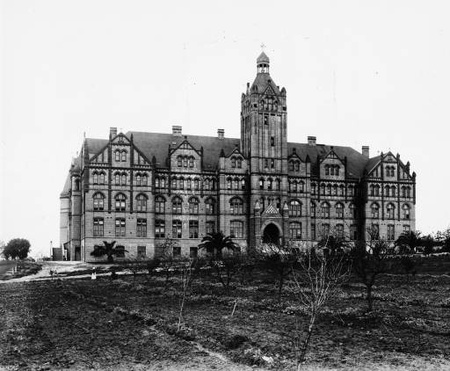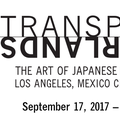The Tale of Osato is an astonishing fable of pre-war Los Angeles, whose protagonist is a determined young Issei who works herself to the point of collapse every night in a Little Tokyo restaurant to support herself and her infant son. In a particularly harrowing passage, Osato places her son in an orphanage located in the nearby neighborhood of Boyle Heights; a last resort for a desperate single mother who realizes that it is impossible for her to care for her child and earn the money for their survival at the same time. It is a decision with a price that she pays for the rest of her life.
In late 2012, Kaya Books, an independent literary publisher based in Los Angeles, debuted Lament in the Night, a collection of two novellas (Lament in the Night and The Tale of Osato) by Nagahara Shōson, for the first time in English. The book includes a historic photograph of the staggering, gothic Los Angeles Orphans’ Asylum, which existed in real life (as did most of the neighborhoods and businesses that appear in Shōson’s novellas) at Boyle and Whittier Boulevard. Only a pale concrete wall and post, decorated with arrows and fluted art-deco lines, remains on that dusty corner today—a ghost from another life.
My involvement with the newly released Lament in the Night began five years ago, when I was invited by Kaya’s publisher and editor, Sunyoung Lee, to meet a young Ph.D. student whose literary work she enthusiastically endorsed. Andrew Leong had already completed the rough translation of a fascinating novella by a previously unknown Issei author and was already working on a second novella by the same writer.
We met in the UC Berkeley dorm cafeteria for lunch with Asian American bookseller, Steve Doi; director of the Center for Japanese Studies, Duncan Williams; and publisher Sunyoung Lee. Over trays of coffee and sandwiches, Andrew began unfolding his story. It was quickly apparent that his intellectual curiosity and the caliber of his work as translator, historian, and literary analyst were stunning. I couldn’t wait to bring Andrew’s book of translations and the lost literature of Nagahara Shōson back to life.
Andrew Leong is a 5th generation Chinese American and 2nd generation Japanese American, born in Oakland, California. His mother spoke to him in Japanese as a child, but by the time he turned five, she stopped and so his dominant language at home was English. In 2001, Andrew went to Japan to visit his mother’s coastal/industrial hometown of Hamamatsu. His cousin was teaching English as a second language to a group of Portuguese speaking people of Japanese descent in the city, and introduced Andrew to a vibrant population of Nikkei-Brazilians working mostly industrial jobs under a special “nikkei visa.” At that time, Andrew couldn’t read much Japanese, (but he could read signs in Portuguese and Spanish since he had majored in comparative literature, with an emphasis on Spanish literature and mathematics), but the experience became the impetus for a serious consideration of Japanese literature found outside of Japan.
He began graduate school in 2004 and began exploring Japanese language literature in the United States by focusing on poetry, such as collections of freestyle haiku by Salinas poet Violet de Cristoforo, or Japanese American tanka edited by Lucille Nixon in the anthology, Sounds of the Unknown. He first came across the name Nagahara Shōson and the book, Lament in the Night (published in 1925 in Little Tokyo) in the annotated bibliography A Buried Past, edited by scholar Yuji Ichioka and published in 1974 by the Japanese American Research Project. The note in Buried Past describes Lament in the Night as:
A novel with the hero as a petty thief and penniless bum. An example of the rarely mentioned Issei failure.1
This immediately spurred Andrew to wonder what Nagahara revealed in his novel of Issei failure. Was there even such a thing as an Issei novel? As an exercise, he went through the entire list of novels available in A Buried Past that piqued his interest, entered these into library search engines and found out which were available for general circulation at UC Berkeley. A copy of Lament in the Night was in the holdings of the East Asian Library, so he checked it out, brought it home, and began translating the novella as an exercise at home, puzzling through the linguistic quirks of the novel and Nagahara’s gritty, naturalist style.
It turned out that “Shōson” (which translates to ‘twilight village’) was merely the author’s pen-name; his true name was Nagahara Hideaki. He was born in 1901 in Yama-no-uchi-nishimura, a small farming village in the mountains of northeastern Hiroshima prefecture. According to Andrew, there are no records of his childhood or his education in Japan, but his father Kiyomaru immigrated to the US shortly after the turn of the century. In 1918, he went to live with his paternal grandfather in the northern section of the city of Hiroshima and on August 9th of that same year, seventeen year old Hideaki boarded the Manila Maru in Kobe destined for Seattle, Washington. He joined his father, who was working as a laborer for the Utah Copper Company in Magna, a mining town several miles outside of Salt Lake City. Although there Japanese population was miniscule, Magna boasted a surprising number of Issei with literary aspirations.
After several months of research into Nagahara’s life, Andrew made a research trip to Los Angeles to visit archives at UCLA and the Japanese American National Museum. He examined copies of Lament in the Night at both institutions, but it was the copy at JANM that he found the most compelling; it still had its original cover and was signed by the author. He also took the opportunity to review microfilm of The Rafu Shimpo, the local newspaper serving the Japanese population in Southern California. Lament in the Night was published in October of 1925 by Sōdosha, a Japanese-language press affiliated with Bunkadō, a bookstore in the heart of Los Angeles’ Little Tokyo. (The Bunkadō bookstore also makes a brief appearance in The Tale of Osato).
It turned out that the day after its publication, Lament in the Night was featured in a front-page review by Kodama Hatsuichirō, who praised Shōson for skillfully portraying the despair felt by many young men following the “prohibition on picture marriage,” a policy instituted by the Japanese government in 1920 that banned the emigration of picture brides. According to Andrew, “By chance, the first reel I looked at had Kodama’s review article. Encouraged, I looked ahead a few weeks and was surprised to find installment after installment of a serial novel. Over the course of three days, I managed to print a complete copy of the text of The Tale of Osato. Now, instead of one “rarely mentioned” example of the “Issei novel,” I had two novels to study.” The Tale of Osato would run in the Rafu Shimpo from November 1925 and May 1926 and became the second novella Andrew would translate, thereby completing the second half of the manuscript that would be published by Kaya.
Lack of further record of Nagahara’s life made it difficult for Andrew to know if he had remained in the United States through the duration of the war, although a brief annotation in his immigration record indicates that he applied for a re-entry permit in December 1927 with the intent of returning to Japan and later coming back to the U.S. There is no documentation of Nagahara ever entering the WWII concentration camps with other west coast Japanese, and the date of his death and the location of his final resting place are also unknown. Still, a third and final literary contribution was discovered in The Japanese Literature of North America Anthology (Hokubei bungei senshū, 1928), by doing a search under Nagahara Hideaki at the National Diet Library in Japan. Andrew is currently translating Nagahara’s last known work, a three-act play entitled The Ones Who Leave (Sariyuku mono), with the hopes that perhaps someday in the near future, the words and characters of this Issei drama could be fleshed out on stage, perhaps right here in Little Tokyo.
For further information on the search for Nagahara Shōson, read Andrew Leong’s brilliant afterword published in Lament in the Night.
Read the interview with a translator Andrew Leong >>
Notes:
1. Yuji Ichioka, et. al., A Buried Past: An Annotated Bibliography of the Japanese American Research Project, (Los Angeles: UC Press, 1974) 125.
* * *
BOOKS & CONVERSATIONS
Lament in the Night by Shoson Nagahara
Saturday, February 23, 2013 • 2PM
Japanese American National Museum
Los Angeles, California
Purchase the book from the Museum Store >>
© 2013 Patricia Wakida







